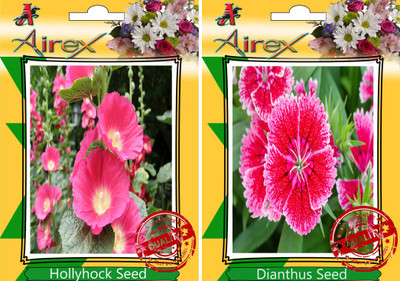Airex Hollyhock, Dianthus Seed(20 per packet)
Quick Overview
Product Price Comparison
Hollyhock Flower Seeds:Description:A group of well grown Hollyhocks in bloom is worth going to see. It is really the color that we look for, because the leaves are large, coarse and grow mostly in clumps at the base of the plant. The long spikes of flowers grow from. 5 feet to 8 feet high and there are usually from five to nine blossoms in bloom on each well grown stalk. The average size is about 2 inches or 3 inches across, but 5-inch blooms can be had if good attention is given. The colors range from white to almost black and include shades of pink, flesh, rose-pink, salmon-rose, golden yellow, canary-yellow, dark red, purple-crimson, dark maroon, white and combinations of practically all these colors with either white centers or white margins. Linnaeus, who named this plant, used both Alcea (Latin form) and Althea(Greek form) from the Greek word for 'to cure'. Dianthus Flower Seeds:Description:Dianthus are among our most favorite plants. Often called Garden Pinks, Their beguiling flower petals may be delicately fringed or ruffled, mostly in light shades of white, pink, and rose. Flecks, edges, or rings of darker colors add to their beauty. And the spicy-sweet fragrance is among the best of all flowers. The narrow leaves form neat mounds of greenish blue and the plants are perfectly suited in a rockery or as an edging. So highly regarded were they by the ancient Greeks that they gave them their name Dianthus, which means ŌĆśFlower of ZeusŌĆÖ, or ŌĆśDivine FlowerŌĆÖ.They grow best in full sun and a fast draining, slightly alkaline soil. They like even moisture; not too wet or dry. Little attention is needed other than deadheading, light shaping, and a bit of well balanced fertilizer in spring. Plants in hot, humid areas are best divided every few years to prevent rotting.Dianthus hybridize readily and have been bred for many centuries. They reached their zenith of popularity in Britain in the mid-1800ŌĆÖs, when it was common for nurseries to list hundreds of varieties. Most of our garden varieties have descended from just 3 of the nearly 300 species: Dianthus caryophyllus (the carnations), Dianthus barbatus (the Sweet Williams), and Dianthus plumarius (the garden pinks), with much interbreeding between them. We have always favored the garden pinks for their true perennial nature, cold hardiness, and winsome charm. No cottage garden pathway would be complete unless there were patches of garden pinks drifting lazily across the stones and the air was laden with their lovely fragrance.


